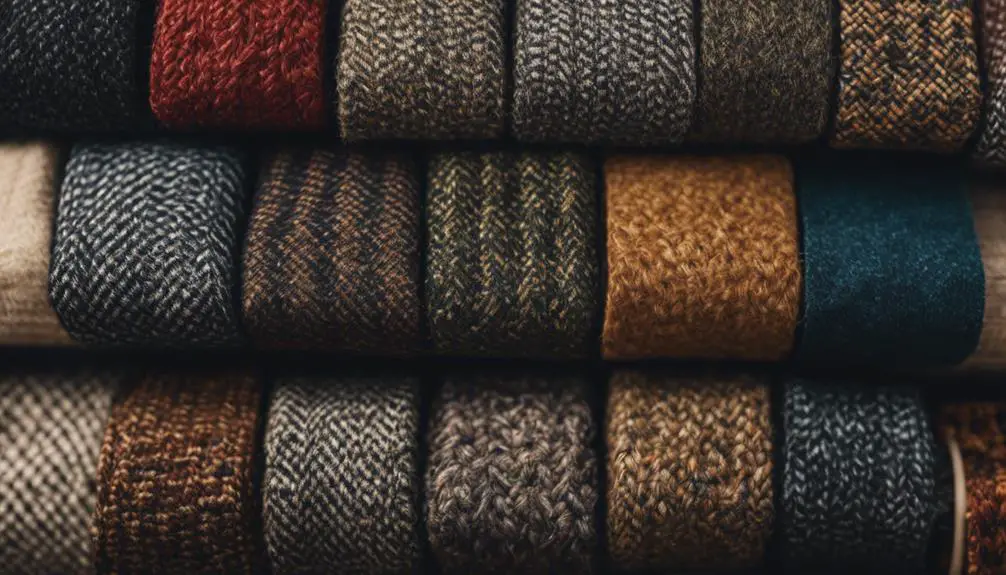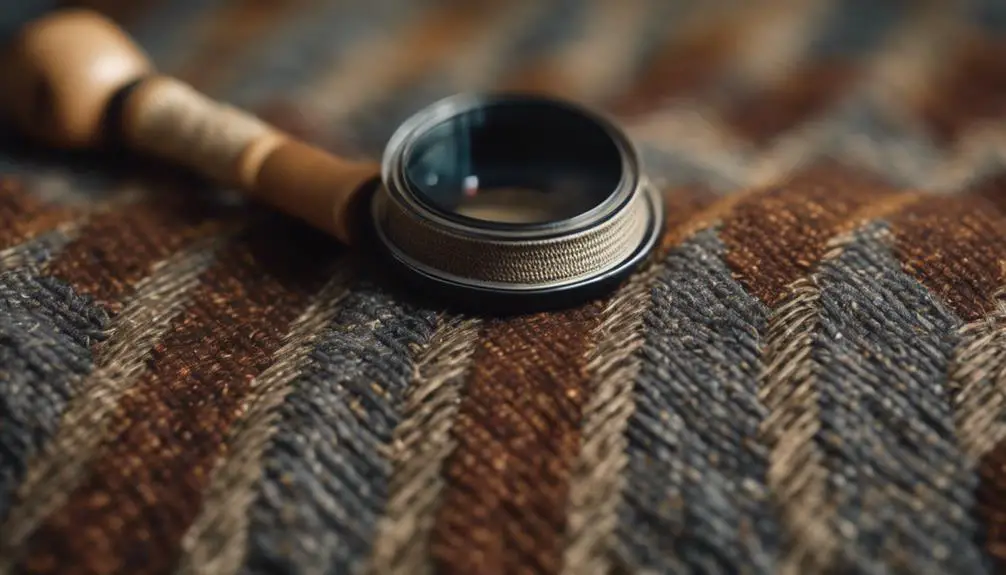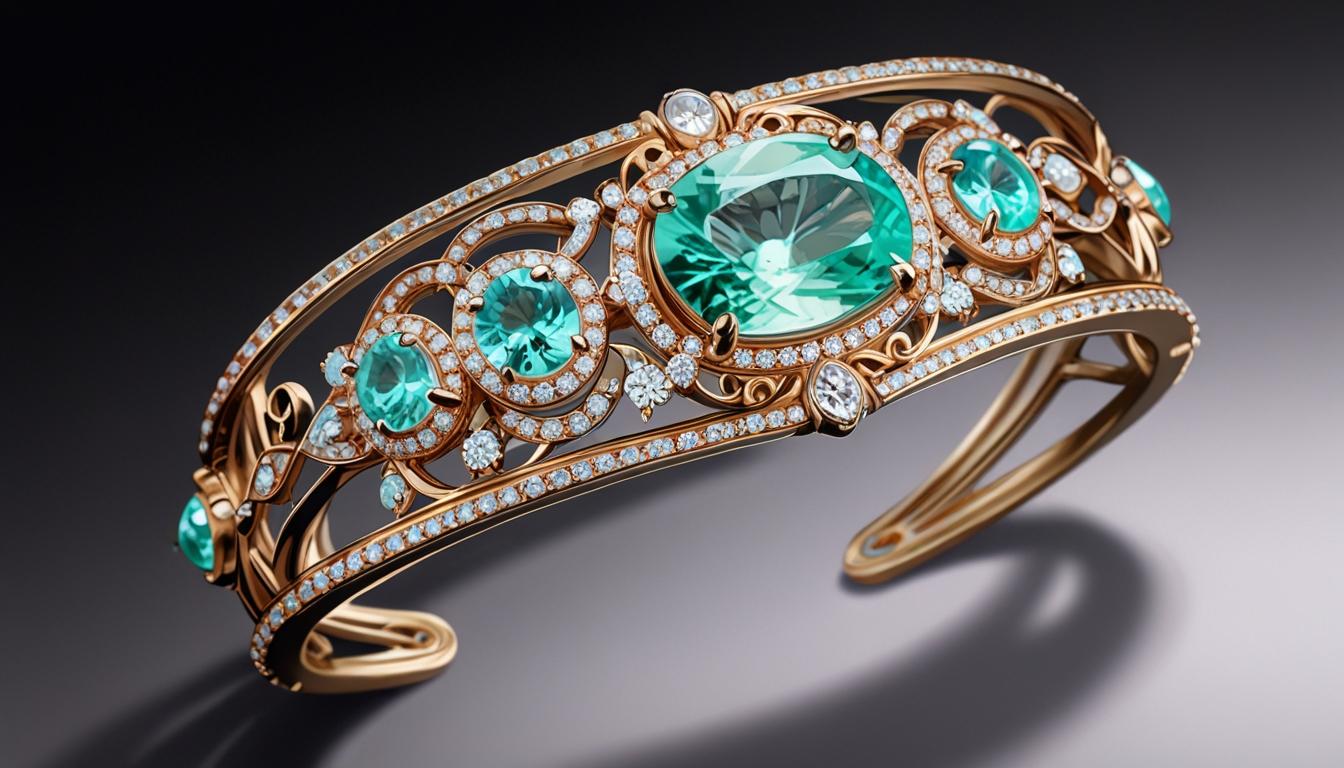To identify tweed, look for its signature rough texture and tight weave. It's primarily made from pure new wool, giving it a sturdy, durable feel. Pay attention to patterns like herringbone, checks, or plaids, often found in muted earth tones. Tweed's weight varies; lightweight styles are suitable for warmer weather, while heavier options offer warmth in chilly conditions. If the fabric is soft and feels cozy against the skin, it's likely tweed. Knowing these key characteristics can help you spot authentic tweed easily. Stick around, and you'll uncover even more fascinating details about this iconic fabric.
Definition of Tweed

Tweed is a distinctive woven fabric made mainly from pure new wool, known for its durability and weather-resistant features. This fabric stands out due to its unique twill weave structure, which not only gives it a rough texture but also enhances its warmth, making it ideal for outdoor activities. Originating from the Scottish Highlands, tweed has become synonymous with rugged sophistication.
When you're identifying tweed, look for that characteristic texture and weight. It comes in various weights, ranging from lightweight options around 300-400 grams for casual wear to heavier varieties between 700-1000 grams suitable for colder conditions. The name "tweed" itself may have roots in the Scottish term "tweel," or it could be linked to the River Tweed, adding to its cultural significance.
Notable types of tweed, like Harris Tweed and Donegal Tweed, exhibit unique patterns and colors, reflecting their regional heritage. When you choose tweed, you're not just selecting a fabric; you're embracing a rich tradition that emphasizes both style and functionality. Whether for jackets, caps, or skirts, tweed remains a timeless choice that highlights durability and elegance in every woven thread.
Historical Background
Originating in the 18th century, this durable fabric was crafted by Scottish farmers to endure the region's harsh winters and damp climates. Known as Clò-Mòr in Gaelic, meaning "the big cloth," tweed fabric quickly became a staple for those living in challenging conditions. The history of tweed took a significant turn in the 1830s when the British aristocracy adopted it for outdoor pursuits, appreciating its weather-resistant properties.
By the 1840s, advancements in production techniques made tweed more accessible and affordable, allowing it to reach a broader audience beyond just the elite. This shift solidified tweed's reputation, particularly for hunting and fishing clothing, where its traditionally woven twill weave proved ideal for outdoor activities.
Interestingly, the name "tweed" emerged from a misinterpretation of the Scottish word "tweel" by a London clerk in 1826, which helped the fabric gain widespread recognition. As you explore the rich history of tweed, you'll see how it evolved from a practical fabric for Scottish farmers to a fashionable choice embraced by many. Understanding this background enhances your appreciation of its unique qualities and enduring appeal.
Types of Tweed

When exploring the various types of tweed, you'll discover a rich tapestry of textures and patterns that cater to different tastes and purposes. Each type has its unique charm and functionality, making them popular choices for different garments.
| Type of Tweed | Description |
|---|---|
| Harris Tweed | Handwoven in the Outer Hebrides, known for quality, and protected by law. |
| Donegal Tweed | Features colorful speckled patterns, creating unique and vibrant designs. |
| Shetland Tweed | Lightweight and soft, characterized by fine texture and subtle patterns. |
| Houndstooth Tweed | Distinctive broken check pattern, ideal for outerwear and accessories. |
| Glen Plaid Tweed | Complex check pattern with varying sizes, perfect for formal wear. |
Understanding these tweed patterns helps you appreciate their distinct characteristics. Whether you're drawn to the vibrant hues of Donegal Tweed or the classic elegance of Houndstooth, each type offers versatility for your wardrobe. Exploring these options can elevate your style, ensuring you find the perfect tweed for any occasion.
Characteristics of Tweed
Although you might admire tweed for its classic appeal, it's the fabric's unique characteristics that truly set it apart. Tweed fabric, with its traditional Scottish roots, is tightly woven to guarantee exceptional durability and warmth, making it a go-to choice for outerwear. The rough texture provides breathability and insulation, perfect for chilly weather.
You'll notice that tweed is available in various weights, ranging from lightweight (300-400 grams) for casual wear to heavier options (700-1000 grams) designed for outdoor activities or colder climates. This versatility means you can find the ideal tweed for any occasion. One of the most notable features of tweed is its water-resistant properties, which come from the natural qualities of wool fibers. This functionality allows you to enjoy the outdoors without worrying about getting soaked.
Tweed also showcases an array of patterns, including herringbone, houndstooth, and checks, often in muted earth tones that enhance its timeless aesthetic. With these characteristics, tweed fabric remains a staple in stylish wardrobes, fulfilling both practical and fashionable needs.
Patterns and Weaving Techniques

Tweed patterns frequently showcase a rich variety of designs that enhance its visual appeal and functionality. You'll find classic styles like Herringbone, which features a distinctive V-shaped weaving pattern, and Barleycorn, resembling small grains. Each pattern serves a purpose, whether for fashion or tradition.
Estate Tweeds, often commissioned for specific hunting estates, embody a sense of heritage, while Clan Tartan Tweeds reflect family lineage and pride. The weaving technique is essential in defining the texture and durability of tweed, with traditional methods contributing to its unique aesthetic.
Beyond Herringbone and Barleycorn, you might also encounter Glen Plaid, which includes checks of varying sizes and is popular in formal wear. If you prefer something more modern, look for Windowpane, showcasing a large check pattern.
Plain Twill offers a simpler diagonal weave, perfect for those who appreciate understated elegance. Each of these tweed patterns not only highlights the craftsmanship involved but also tells a story, making your choice of tweed more than just a fashion statement. Understanding these patterns and techniques helps you appreciate the rich heritage behind every piece.
Care and Maintenance
Maintaining the beauty and functionality of your tweed garments requires some care. To guarantee your tweed jacket retains its shape and texture, always have it dry cleaned when necessary. This prevents shrinkage and keeps the fabric looking fresh. Store your tweed jackets on quality padded hangers; this helps preserve their structure while preventing creasing. Cover them with breathable fabric to keep moths and dust at bay.
When it comes to trousers and accessories, fold them neatly and store them in drawers to maintain their appearance. Regular brush your tweed to remove dirt and lint—this simple step enhances the texture and keeps your garments looking sharp. For localized stains, act quickly. Use a mild detergent and gently blot the area instead of rubbing, as excessive friction could damage the fibers.
Styling Tips for Tweed

Embracing the versatility of tweed can elevate your style effortlessly. Start by pairing tweed jackets with chinos or well-fitted jeans for a balanced casual look that still feels sophisticated. This combination strikes the perfect note between effortless and polished. To complete your outfit, accessorize with leather brogues or boots, enhancing the rugged yet refined aesthetic that tweed embodies.
If you're aiming for a more formal appearance, opt for a tailored tweed suit. Look for distinctive elements like leather buttons and a waistcoat to add an extra touch of style. For cooler weather, layer with a lightweight knit or a fine-gauge sweater under your jacket for comfort and warmth without sacrificing elegance.
Don't forget about accessories! Incorporating tweed caps or scarves can add character to your ensemble without overwhelming your overall look. These small details can tie your outfit together, showcasing your appreciation for the fabric's heritage while keeping it modern. With these styling tips, you'll make tweed a staple in your wardrobe, ensuring you stay chic and comfortable in any setting.
Frequently Asked Questions
How Can You Tell if Fabric Is Tweed?
You can tell if fabric is tweed by feeling its rough texture and checking for a tight weave. Look for patterns like herringbone or checks, and notice its weighty, warm nature typical of wool.
What Is Considered Tweed?
Tweed's considered a robust, woven fabric made primarily from wool. It features unique patterns like herringbone and houndstooth, providing warmth and style for various occasions, especially in colder climates and outdoor settings.
What Is the Difference Between Tweed and Harris Tweed?
Tweed is a general fabric, while Harris Tweed's unique because it's handwoven in the Outer Hebrides. You'll notice its strict quality standards, rich colors, and patterns, all protected by law, ensuring its authenticity.
How to Tell if Harris Tweed Is Real?
To tell if Harris Tweed is real, check for the Orb logo, feel the robust yet soft texture, and look for rich colors and patterns. A label with the weaver's name confirms its authenticity.





Cryptocurrency regulation updates
Thank you for your sharing. I am worried that I lack creative ideas. It is your article that makes me full of hope. Thank you. But, I have a question, can you help me?